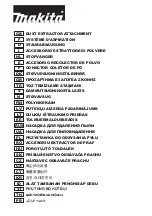
5 - English
SPECIFIC SAFETY RULES
Know your handheld inflator. Read operator’s manual
carefully. Learn its applications and limitations, as well
as the specific potential hazards related to this prod-
uct. Following this rule will reduce the risk of electric
shock, fire, or serious injury.
Risk of Bursting. Do not preset handheld inflator to re-
sult in output pressure greater than marked maximum
pressure of item to be inflated. Do not use at pressure
greater than 200 psi.
To reduce the risk of electric shock, do not expose
to rain. Store indoors.
Inspect yearly for cracks, pin holes, or other
imperfections that could cause handheld inflator
to become unsafe. Never cut or drill holes in the
handheld inflator.
Make sure the hose is free of obstructions or
snags. Entangled or snarled hoses can cause loss of
balance or footing and may become damaged.
Use the handheld inflator only for its intended use.
Do not alter or modify the unit from the original
design or function.
Always be aware that misuse and improper handling
of this product can cause injury to yourself and
others.
Never leave a handheld inflator unattended with the
air hose attached.
Do not continue to use a handheld inflator or hose
that leaks air or does not function properly.
Always disconnect the air supply and power supply
before making adjustments, servicing a handheld
inflator, or when an handheld inflator is not in use.
Do not attempt to pull or carry the handheld inflator
by the hoses.
Always follow all safety rules recommended by the
manufacturer of your handheld inflator, in addition
to all safety rules for the product. Following this rule
will reduce the risk of serious personal injury.
Do not use handheld inflator as a breathing device.
Never direct a jet of compressed air toward people
or animals. Take care not to blow dust and dirt
towards yourself or others. Following this rule will
reduce the risk of serious injury.
Protect your lungs. Wear a face or dust mask if the
operation is dusty. Following this rule will reduce the
risk of serious personal injury.
Do not use this handheld inflator to spray chemi-
cals. Your lungs can be damaged by inhaling toxic
fumes.
Check damaged parts. Before further use of the
handheld inflator, a guard or other part that is
damaged should be carefully checked to deter-
mine that it will operate properly and perform its
intended function. Check for alignment of moving
parts, binding of moving parts, breakage of parts,
mounting, and any other conditions that may affect
its operation. A guard or other part that is damaged
should be properly repaired or replaced by an au-
thorized service center. Following this rule will reduce
the risk of shock, fire, or serious injury.
Battery tools do not have to be plugged into an
electrical outlet; therefore, they are always in
operating condition. Be aware of possible hazards
when not using your battery tool or when changing
accessories. Following this rule will reduce the risk of
electric shock, fire, or serious personal injury.
Do not place battery tools or their batteries near
fire or heat. This will reduce the risk of explosion and
possibly injury.
Do not crush, drop or damage battery pack. Do
not use a battery pack or charger that has been
dropped or received a sharp blow. A damaged
battery is subject to explosion. Properly dispose of a
dropped or damaged battery immediately.
Batteries can explode in the presence of a source
of ignition, such as a pilot light. To reduce the risk of
serious personal injury, never use any cordless product
in the presence of open flame. An exploded battery
can propel debris and chemicals. If exposed, flush with
water immediately.
Do not charge battery tool in a damp or wet
location. Following this rule will reduce the risk of
electric shock.
For best results, your battery tool should be
charged in a location where the temperature is
more than 50°F but less than 100°F. To reduce the
risk of serious personal injury, do not store outside or
in vehicles.
Under extreme usage or temperature conditions,
battery leakage may occur. If liquid comes in
contact with your skin, wash immediately with soap
and water. If liquid gets into your eyes, flush them
with clean water for at least 10 minutes, then seek
immediate medical attention. Following this rule will
reduce the risk of serious personal injury.
Save these instructions. Refer to them frequently and
use them to instruct others who may use this handheld
inflator. If you loan someone this handheld inflator, loan
them these instructions also.
Содержание 315.115860
Страница 22: ...11 Español NOTES NOTAS ...
Страница 23: ...12 Español NOTES NOTAS ...






































